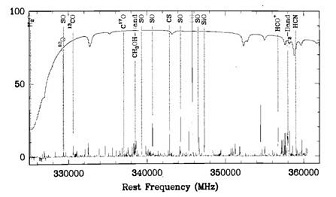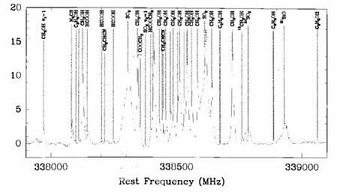Line Surveys

Figure: Composite Spectrum. Composite spectrum |

Figure: Orion Molecular Cloud. Detail of the 338-339 |
Figure: Zenith Atmospheric Transmission. Zenith
atmospheric transmission from Mauna Kea.
In addition to using a single molecule like CO to study the astrophysical dynamics of galactic
properties such as star formation, astronomers are also keenly interested in the chemistry of the
interstellar clouds themselves. The molecular cloud in Orion is particularly well suited for study both
because of its size and proximity (~500 pc; 2000 LY). There have been many line surveys of this source
over the years, but a good example is that of Schilke, Groesbeck, Blake, and Phillips [1]. For this study the CSO instrument atop Mauna Kea listed in
Table V.B.1-1 was used
to survey the 325-360 GHz region. About 2200 lines were observed; an overview is shown in
Figure: Composite Spectrum. Composite spectrum
of the 325-360 survey of the Orion molecular cloud
taken by the CSO instrument on Mauna Kea.
Figure: Composite Spectrum. Composite spectrum
of the 325-360 survey of the Orion molecular cloud
taken by the CSO instrument on Mauna Kea.
References
- A Line Survey of the Orion KL from 325 to 360 GHz Astrophys. J., Suppl. Ser. 108, 301 (1997). Google Scholar
- A Line Survey of Orion-KL from 607 - 725 GHz Astrophys. J., Suppl. Ser. 132, 281-364 (2001). Google Scholar
- Submillimeter atmospheric transmission measurements on Mauna Kea during extremely dry El Nino conditions: implications for broadband opacity contributions J. Quant. Spectrosc. Radiat. Transfer 68, 419-433 (2001). Google Scholar